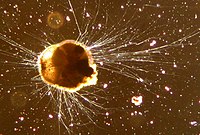Ammonia tepida
|
Ammonia tepida Temporal range: M Cretaceous - recent |
|
|---|---|
 |
|
| Live Ammonia tepida | |
| Scientific classification | |
| Domain: | Eukaryota |
| (unranked): | SAR |
| (unranked): | Rhizaria |
| Superphylum: | Retaria |
| Phylum: | Foraminifera |
| Order: | Rotaliida |
| Superfamily: | Rotalioidea |
| Family: | Rotaliidae |
| Genus: | Ammonia |
| Species: | A. tepida |
| Binomial name | |
|
Ammonia tepida Cushman, 1926 |
|
| Synonyms | |
|
Ammonia beccarii var. tepida Cushman, 1926 |
|
Ammonia beccarii var. tepida Cushman, 1926
Rotalia beccarii var. tepida Cushman, 1926
Streblus beccarii var. tepida (Cushman, 1926)
Ammonia tepida is a benthic foraminifer living in the sediment of brackish waters. It is very similar to Ammonia beccarii, but the latter lives on the surface of red algae.
Ammonia tepida is found in the sediment of brackish waters worldwide. It is able to tolerate a wide range of temperatures and degrees of salinity, as well as to survive severe environmental conditions. As it is easy to keep in the laboratory, being able to reproduce both asexually and sexually without problem, it considered an ideal organism for laboratory studies.
The diet of A. tepida consists mainly of other microorganisms. Algae form about 80–90% of its diet and the remaining is composed by bacteria. Laboratory experiments showed that it may also prey on small animals, such as nematodes, copepods and mollusk larvae.
Ruiz, Francisco; Gonzalez-Regalado, Maria Luz; Abad, Manuel; Munoz, Juan Manuel; Pino, Rafael (October 2007). "New applications of the Poisson distribution in micropalaeontology: relationships between environmental variables and the Ammonia tepida distribution in the south-western Spanish estuaries". Terra Nova. 19 (5): 372. doi:10.1111/j.1365-3121.2007.00761.x.
...
Wikipedia
